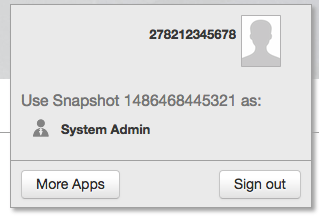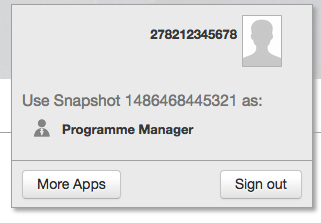Versions Compared
Key
- This line was added.
- This line was removed.
- Formatting was changed.
As a System Admin I want to see my role name differently depending on whether I'm a developer or a client.
| Table of Contents |
|---|
Lesson Outcomes
After this lesson you should know the purpose and usage of the @RoleName annotation.
Purpose
The @RoleName annotation allows a custom role name to be displayed in the app that differs from role name specified in the data model and can be determined at runtime.
Using the tutorial app as an example, the "System Admin" role might be given to developers (or in-field technicians, etc.) tasked with the initial setup of the app (such as inviting the first client users), as well as to client users. Consider a scenario wherein for client users the "System Admin" role name sounds like a technical role and therefor confusing. We can use @RoleName to have their role displayed on the mouseover in the right-hand corner of the screen as e.g. "Programme Manager" instead.

New & Modified App Files
./model/enums/Enums.mez
./model/roles/SystemAdmin.mez
./services/CustomRoleName.mez
./services/UserInvite.mez
./web-app/lang/en.lang
./web-app/views/user_management/SystemAdminUserMgmt.vxml
Usage
A method that
- has the
@RoleNameannotation, - takes an object instance of the role object as parameter, and
- returns a
string
anywhere in the app, will define what the currently logged in user will see, based on the method logic. We'll create a services/CustomRoleName.mez file, containing a unit of the same name, in turn containing our @RoleName method (shown below). We also need to add a flag to the SystemAdmin object to distinguish between the two types of system administrators, and the necessary changes to make the flag take effect.
| Code Block | ||||
|---|---|---|---|---|
| ||||
unit CustomRoleName;
@RoleName
string getSystemAdminRoleName(SystemAdmin systemAdmin) {
if (systemAdmin.roleName == EN_SYSTEM_ADMIN_ROLE_NAME.System_Admin) {
return "System Admin";
} else {
return "Programme Manager";
}
} |
The above (together with the required flag attribute on the SystemAdmin object, new enum, a change to the @InviteUser-annotated inviteSystemAdmin() method, and change to the view for creating or editing SystemAdmin records, to round it all of), will lead to the mouseover in the right-hand corner looking like this for system administrators flagged as "Programme Managers":

Lesson Source Code